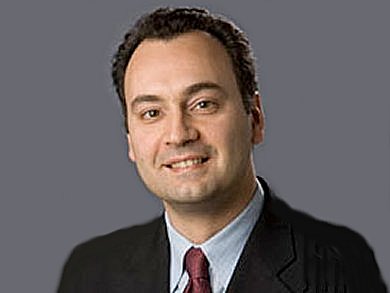Organic electronics can link the fields of electronics and biology, as organics have the ability to conduct both electronic and ionic charges. Interviewed by Dr. Vera Koester for ChemViews magazine, Professor George Malliaras explains why this creates a lot of fascinating physical phenomena and can yield many novel devices.
Professor George Malliaras is the Head of the Department of Bioelectronics (BEL) at the Centre Microélectronique de Provence of the Ecole Nationale Supérieure des Mines de Saint Etienne, France. His research on organic electronics and bioelectronics has been recognized with many awards.
Professor Malliaras, you are well known for your research on organic electronics. Can you please tell us a bit about your research in this field?
Organic electronics employ carbon based materials. This contrasts with traditional electronics, which rely on inorganic conductors and semiconductors, such as copper and silicon. The “soft” nature of organic materials offers better compatibility with tissue than traditional electronic materials.
A couple of years ago, we started to look into potential applications of organic electronics. At our department, we are exploring three applications:
The first one is new tools for neurosciences. These are devices that can record or stimulate neuronal activity.
The second application is diagnostics. Here we use living cells as the recognition elements. The cells themselves are used like canaries in mines. Miners would take a canary down in the mine to detect poisonous gas. If the canary died then they would run out of the mine. The emphasis is to minimize the use of laboratory animals in testing of pharmaceuticals, cosmetics, and things like that.
The third application is tissue engineering. Particularly, we focus on electrical control of cell adhesion and migration on conducting polymerized surfaces.
My own research focus is on developing tools for neurosciences.
What is so fascinating about organic electronics?
Underlying all these exciting applications is the mixed conductivity these materials exhibit. Organic electronic materials can transport not only electronic carriers, holes or electrons, but also ions. And as such, they offer a very good interface between the worlds of solid state electronics and biology. In biology signals often consist of ions. Solid state electronics utilize holes and electrons. Organic electronic materials can link these two worlds by allowing the interplay between ionic and electronic carriers.
Have you already tested these applications in live organisms?
For the development of the tools for neurosciences we work together with a hospital. The team there focuses on epilepsy and has the appropriate animal models.
We try to improve the recording of brain activity and have developed recording devices that can measure brain activity with a higher signal to noise ratio. We also do some work on stimulation.
Where do you see this application going?
What we want to do down the road is to develop implantable devices that can give us information on electrophysiology and metabolism and by this allow advanced disease detection and treatment. For this we need to combine two approaches: There is the approach of electrophysiology which measures the electrical activity which underlies cell communication. And then there is the imaging community that looks into metabolism, basically into what cells eat and which part of the brain consumes nutrients at what time.
How important is an interdisciplinary approach in research?
Interdisciplinarity is absolutely necessary. If you start as an engineer or a materials person trying to break into life sciences applications without feedback from that community, I would say that the work will be rather irrelevant.
In our department we have a very mixed group of scientists from various backgrounds like physicists, materials engineers, electrical engineers, biologists, and even neuroscientists. As a result, during our regular group meetings, most of the ideas for new projects get killed before they gain any traction. If, for example, an engineer says, “Oh, wouldn’t it be cool to measure this?”, the neuroscientist might say “No”. And then the neuroscientist would say, “Oh, wouldn’t it be cool if you guys could make a device that does that?” and the engineers say this is too boring or this is not possible. So the one idea out of the twenty or fifty that survives is the one that we have got to pursue.
I think in interdisciplinary research the most important thing is to find the question that excites all sides. And this takes a while. It also takes a while to understand what your collaborators need and how a thing like this could be made.
Do you think emphasis on interdisciplinary research is already important in teaching students?
On a graduate level definitely interdisciplinary research is a great thing. For an undergraduate it is still a subject of debate. One school of thought is that you still should have your solid grounding in traditional discipline. But at the very least, you should be able to understand a little bit of the language of the other fields.
What do you like most about your job?
Working with students. It is something that keeps you young, refreshes you. There is always somebody in my group coming in with new ideas and lots of excitement. I like the team spirit when we all work together. That is a lot of fun.
And being a scientist is a wonderful career. We are paid to play with toys – expensive toys that is, to think of new things, to experiment. This is a wonderful thing and I would do it without payment, but don’t tell that to my employer.
And what fascinates you most about your research?
I have been working in organic electronics for many years. I started my Ph.D. in 1991 in organic electronics. I have made a lot of different devices, for example, light emitting diodes for displays and lighting, solar cells, transistors for low cost electronics. Organic electronics has long been copying traditional electronics. Now, the interface with life sciences is the most exciting for me.
First of all, it is really truly interdisciplinary; you have to work with the medical community, with biologists. And second, these are really devices that will have an impact. They will improve quality of life as well as the span of life. They will help people who suffer, so they are wonderful applications.
And what do you like most outside of science?
Spending time with my family. I have two small children, so that takes a lot of time, but it is also a lot of fun.
Thank you for this interview.
 Professor George Malliaras is the Head of the Department of Bioelectronics (BEL) at the Centre Microélectronique de Provence of the Ecole Nationale Supérieure des Mines de Saint Etienne, France. He received a BS in Physics from the Aristotle University, Greece, in 1991, and a Ph.D. in Mathematics and Physical Sciences from the University of Groningen, the Netherlands, in 1995. After a two year postdoctoral research position at the IBM Almaden Research Center, California, USA, he joined the faculty in the Department of Materials Science and Engineering at Cornell University, New York, USA. From 2006 to 2009 he served as the Lester B. Knight Director of the Cornell NanoScale Science & Technology Facility. He joined the Centre Microélectronique de Provence in the Fall of 2009.
Professor George Malliaras is the Head of the Department of Bioelectronics (BEL) at the Centre Microélectronique de Provence of the Ecole Nationale Supérieure des Mines de Saint Etienne, France. He received a BS in Physics from the Aristotle University, Greece, in 1991, and a Ph.D. in Mathematics and Physical Sciences from the University of Groningen, the Netherlands, in 1995. After a two year postdoctoral research position at the IBM Almaden Research Center, California, USA, he joined the faculty in the Department of Materials Science and Engineering at Cornell University, New York, USA. From 2006 to 2009 he served as the Lester B. Knight Director of the Cornell NanoScale Science & Technology Facility. He joined the Centre Microélectronique de Provence in the Fall of 2009.
His research on organic electronics and bioelectronics has been recognized with awards from the New York Academy of Sciences, the US National Science Foundation, and DuPont. He is a co-author of over 180 publications in peer-reviewed journals that have received over 6,000 citations.
Selected Publications
- Electrical control of protein conformation,
A. M. D. Wan, R. M. Schur, C. K. Ober, C. Fischbach, D. Gourdon, G. G. Malliaras,
Adv. Mater. 2012, 24 (18), 2501–2505.
DOI: 10.1002/adma.201200436
- Highly conformable conducting polymer electrodes for in vivo recordings,
D. Khodagholy, T. Doublet, M. Gurfinkel, P. Quilichini, E. Ismailova, P. Leleux, T. Herve, S. Sanaur, C. Bernard, G.G. Malliaras,
Adv. Mater. 2011, 36 (26), H268–H272.
DOI: 10.1002/adma.201102378 - Detection of transmitter release from single living cells using conducting polymer microelectrodes,
S. Y. Yang, B. N. Kim, A. A. Zakhidov, P. G. Taylor, J.-K. Lee, C. K. Ober, M. Lindau, G. G. Malliaras,
Adv. Mater. 2011, 23 (24), H184–H188.
DOI: 10.1002/adma.201100035 - Organic electronics at the interface with biology,
R. M. Owens, G. G. Malliaras,
MRS Bulletin 2010, 35, 449–456.
DOI: 10.1557/mrs2010.583 - An organic electronics primer,
G. G. Malliaras, R. H. Friend,
Physics Today 2005, 58, 53.
DOI: 10.1063/1.1995748




